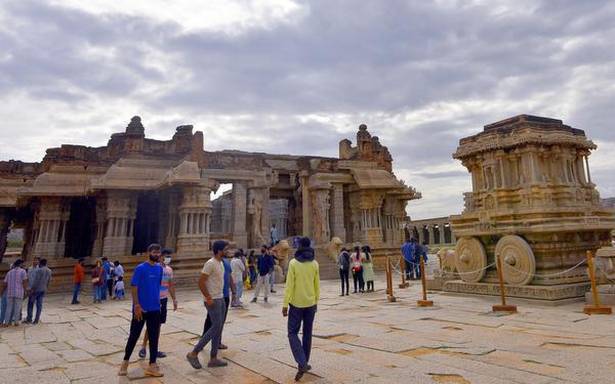The World Heritage Site in Karnataka was closed for over two months during the second wave of COVID-19
Tourists have begun to make their way to Hampi, a World Heritage Site that was closed for over two months during the second wave of COVID-19. The site was opened to visitors in the last week of June.
Though the Union government had decided to open sites managed by Archaeological Survey of India (ASI) from June 16, Hampi remained closed for some more days owing to a high number of COVID-19 cases in Vijayanagara and Ballari districts. The administration lifted restrictions on June 24 after the positivity rate dropped below 5% in the twin districts, and allowed the entry of tourists.
Yet, footfall remained unimpressive as restrictions as the administration continued with the curfew on weekends. As per information provided by ASI, 365 tourists bought tickets at the Lotus Mahal counter and 422 at Vittala Temple counter in the first three days after the reopening. There were several instances of tourists from Maharashtra, Telangana and Andhra Pradesh, who were unaware of the weekend curfew, returning without being able to enter the site.
The removal of weekend curfew on July 3 has triggered enthusiasm among the people who were locked up in their homes for months. The pleasant monsoon breeze under a cloudy sky has made Hampi even more attractive.
As a result, the daily footfall went up considerably on the weekend. Tourists were seen at all the major attractions, including Virupaksha temple, Vittala temple, Lotus Mahal, elephant stables, queen’s bath place and Mahanavami Dibba.
As per information provided by ASI, 1966 tourists, including a foreign national, visited Hampi on July 10 and 1,964, including two foreign nationals, on July 11. The daily footfall on weekdays has crossed 750.
The increase in arrival of tourists would be a welcome sign for the local economy, which was hit hard by the COVID-19 lockdown. It has raised the hopes of all the people who were dependent on tourism activities – taxi drivers, tourist guides, hoteliers, home-stay operators, shopkeepers, and roadside vendors.
Gopal, a tourist guide, told The Hindu, “Hampi has around 150 tourist guides. All of us are completely dependent on tourism for our survival. The two lockdowns imposed during the first and second waves of the COVID-19 pandemic proved to be very bad for us as we didn’t have any other means of livelihood. I worked on an NREGA project for a few days. But, when the government stopped that project, I had to borrow money from my friends and relatives to feed my family. Sudha Murthy of Infosys Foundation helped guides by offering ₹10,000 twice. Now, we are happy that the Hampi is finally open and tourists are coming here.”
Hampi is like an open museum of monuments scattered in a large area on the bank of Tungabhadra river. It is difficult to visit all the monuments on foot. However, COVID-19 scare is such that many tourists prefer to visit the sites on their own instead of hiring a guide to minimise interaction while travelling from one monument to the other.
“I earned ₹800 on Saturday and ₹1,000 on Sunday. On Tuesday, I was not hired by any tourist,” Mr. Gopal added.
Source: Read Full Article

